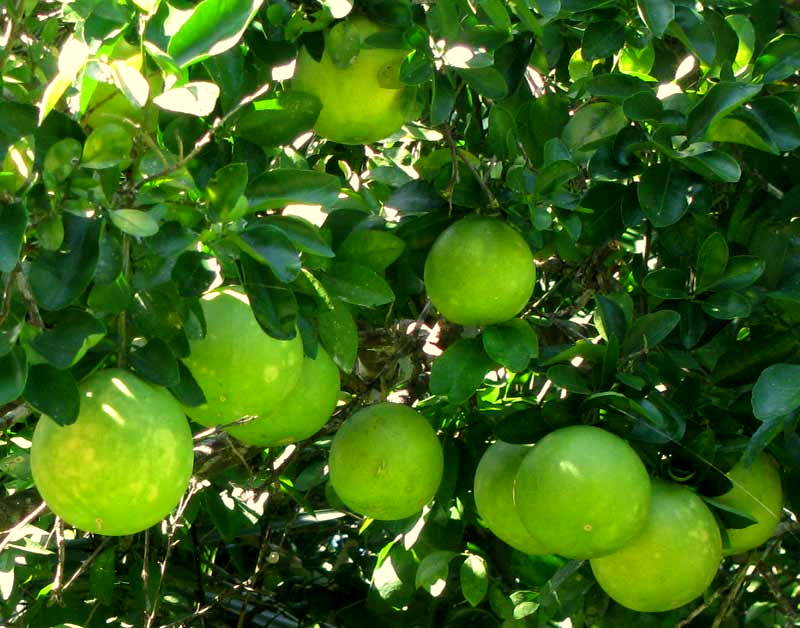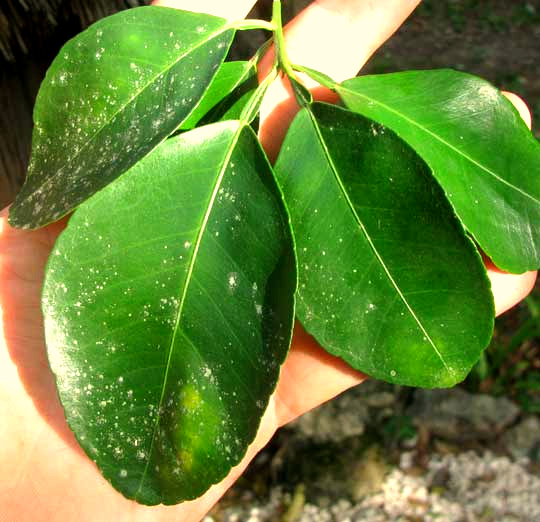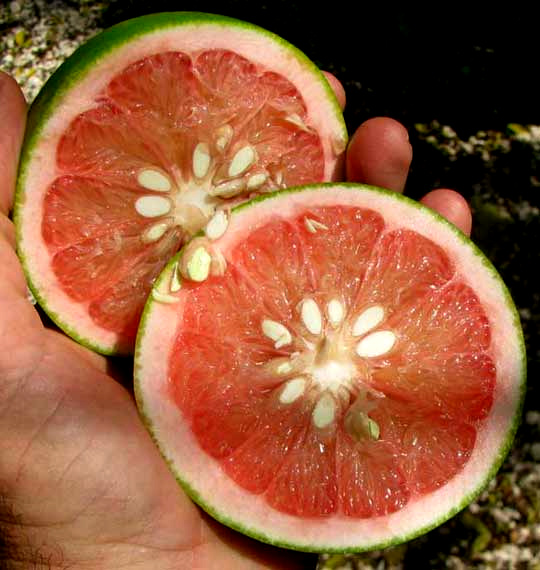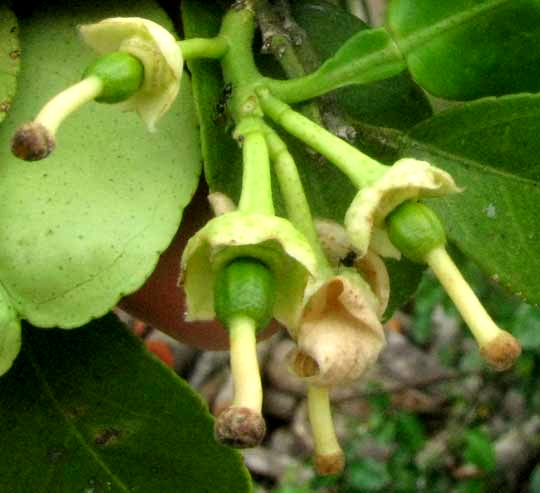Excerpts from Jim Conrad's
Naturalist Newsletter

from the November 20, 2011 Newsletter issued from Hacienda Chichen Resort beside Chichén Itzá Ruins; limestone bedrock; elevation ~39m (~128ft), N20.675°, W88.569°; central Yucatán state, MÉXICO
GRAPEFRUITS IN TREES
A pretty thing to see nowadays is big, round, yellowing grapefruits in dark green trees beside shady village homes. You can see a typical cluster above. Grapefruits, like oranges and lemons, are citrus fruits, which means that they belong to the genus Citrus. Below, you can see their typical citrus leaves with "winged petioles" causing the leaves to look jointed at their bases; orange and lemon leaves do the same:

A sliced-open grapefruit off the tree whose leaves are shown, with thicker rind and more seeds than I'm used to in grapefruits bought in the US is shown below:

I'm wondering whether in that thick rind and numerous seeds there might be a story? For, the technical name for the Grapefruit tree is CITRUS x PARADISI, the "x" in the middle meaning that we're dealing with a hybrid. In other words, there's no "Wild Grapefruit" out in the wild from which today's grapefruit plants have been developed. The first grapefruits came into being in Barbados in the 1700s when an Orange plant, Citrus x sinensis, was crossed with a Pomelo, Citrus maxima, both species originally being from southern Asia, and Orange plants themselves being hybrids.
Pomelo (pom-EH-loh) fruits are very similar to grapefruits but much larger, their rinds are grossly thicker, and the wedge-shaped cells seen in cut-open fruits normally are more unevenly sized, causing the rind to be thicker above some cells than others. When I saw how thick-rinded, seedy and relatively dry-fleshed our grapefruit was, I wondered whether its parent tree might not have had more pomelo genes in it than most modern grapefruit trees do. Maybe grapefruit trees around homes in isolated little Maya villages derive from stock brought to the Yucatán by the Spanish during colonial times, before plant breeders produced cultivars with thinner rinds, fewer seeds and juicier flesh.
In fact, I'll bet that the Yucatán's little Maya villages are great places to find old strains of many cultivars, maybe strains going extinct out in the world as flashier ones take their place. And maybe sometimes the old strains have resistance to diseases or flavors or textures that newer ones don't.
While reviewing information on grapefruits I found that Wikipedia's grapefruit page not only has the usual praise of grapefruits and their juice as being especially nutritious and even medicinal, but also there's an interesting section on the grapefruit fruit's "drug interactions."
For, studies show that some compounds in grapefruit increase the effective potency of certain medicinal compounds, particularly those known as statins. This came to light when several deaths from overdoses occurred among people on medication who ate grapefruit -- grapefruit made their medicines too powerful. Grapefruit juice also can interfere with etoposide, a chemotherapy drug, some beta blocker drugs used to treat high blood pressure, and cyclosporine, taken by transplant patients to prevent rejection of their new organs. Grapefruit is powerful stuff! The Wikipedia page is at https://en.wikipedia.org/wiki/Grapefruit.
from the March 11, 2012 Newsletter issued from Hacienda Chichen Resort beside Chichén Itzá Ruins; limestone bedrock; elevation ~39m (~128ft), N20.675°, W88.569°; central Yucatán state, MÉXICO
GRAPEFRUIT FLOWERS
Wandering through the nearby little Maya town of Libre Union last Sunday we came upon the blossoms shown below:

As indicated by the "winged petiole" of the leaf in the picture's upper right corner, this is obviously the flower of some kind of citrus species; neighbors sitting nearby on their rock fence told me the tree was a Grapefruit.
The flowers are past their prime, for their waxy-white corollas and stamens have fallen off, leaving in each blossom only a large, cuplike calyx, in the center of which arises a green, fast enlarging ovary, atop which arises a surprisingly thick style tipped with a large, blunt, brown stigma.